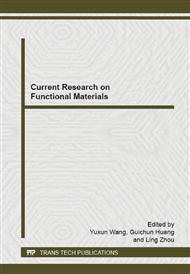[1]
Tongpoothorn W, Sriuttha M, Homchan P, et al. Preparation of activated carbon derived from Jatropha curcas fruit shell by simple thermo-chemical activation and characterization of their physico-chemical properties [J]. Chemical Engineering Research and Design, 2011, 89 (3): 335-340.
DOI: 10.1016/j.cherd.2010.06.012
Google Scholar
[2]
Liu B G, Peng J H, Srinivasakannan C, et al. Coupling and absorbing behavior of microwave irradiation on the Co(C(2)O(4)center dot 2H(2)O: Co(3)O(4) system[J]. Bioresource Technology, 2011, 42 (1): 92-96.
Google Scholar
[3]
Purnomo C W, Salim C, Hinode H. Effect of the activation method on the properties and adsorption behavior of bagasse fly ash-based activated carbon[J]. Fuel Processing Technology, 2012, 102: 132-139.
DOI: 10.1016/j.fuproc.2012.04.037
Google Scholar
[4]
Ould-Idriss A, Stitou M, Cuerda-Correa E M, et al. Preparation of activated carbons from olive-tree wood revisited. I. Chemical activation with H3PO4[J]. Fuel Processing Technology, 2011, 92 (2): 261-265.
DOI: 10.1016/j.fuproc.2010.05.011
Google Scholar
[5]
Auta M, Hameed B H. Preparation of waste tea activated carbon using potassium acetate as an activating agent for adsorption of Acid Blue 25 dye[J]. Chemical Engineering Journal, 2011, 171 (2): 502-509.
DOI: 10.1016/j.cej.2011.04.017
Google Scholar
[6]
Li T H, Zhu L, Wang X X, et al. Preparation of activated carbons by microwave heating KOH activation[J]. Applied Surface Science, 2007, 254 (2): 506-512.
DOI: 10.1016/j.apsusc.2007.06.034
Google Scholar
[7]
Adinata D, Daud W, Aroua M K. Preparation and characterization of activated carbon from palm shell by chemical activation with K2CO3[J]. Bioresource Technology, 2007, 98 (1): 145-149.
DOI: 10.1016/j.biortech.2005.11.006
Google Scholar
[8]
Foo K Y, Hameed B H. Utilization of rice husks as a feedstock for preparation of activated carbon by microwave induced KOH and K2CO3 activation[J]. Bioresource Technology, 2011, 102: 9814-9817.
DOI: 10.1016/j.biortech.2011.07.102
Google Scholar
[9]
Alam M Z, Muyibi S A, Toramae J. Statistical optimization of adsorption processes for removal of 2, 4-dichlorophenol by activated carbon derived from oil palm empty fruit bunches[J]. Journal of Environmental Sciences, 2007, 19 (6): 674-677.
DOI: 10.1016/s1001-0742(07)60113-2
Google Scholar
[10]
Karacana F, Ozdena U, Karacanb S. Optimization of manufacturing conditions for activated carbon from Turkish lignite by chemical activation using response surface methodology[J]. Applied Thermal Engineering, 2007, 27 (7): 1212-1218.
DOI: 10.1016/j.applthermaleng.2006.02.046
Google Scholar
[11]
Manikandan M, Pašić L, Kannan V. Optimization of growth media for obtaining high-cell density cultures of halophilic archaea (family Halobacteriaceae) by response surface methodology[J]. Bioresource Technology, 2009, 100 (12): 3107-3112.
DOI: 10.1016/j.biortech.2009.01.033
Google Scholar
[12]
Ai H. Study on Cleaning Preparation, Properties and Application of Activated Carbon from Sugarcane Leaves[D]. Guilin: guangxi normal university, (2013).
Google Scholar
[13]
Azargohara R, Dalai A K. Steam and KOH activation of biochar: Experimental and modeling studies[J]. Microporous and Mesoporous Materials, 2008, 110 (3): 413-421.
DOI: 10.1016/j.micromeso.2007.06.047
Google Scholar


